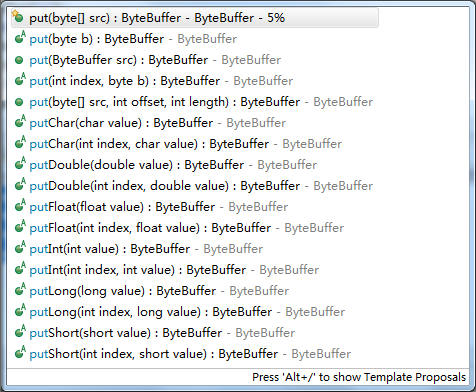JAVA直接記憶體(堆外記憶體)
本篇主要講解如何使用直接記憶體(堆外記憶體),並按照下面的步驟進行說明:
| 1 |
相關背景-->讀寫操作-->關鍵屬性-->讀寫實踐-->擴充套件-->參考說明
|
希望對想使用直接記憶體的朋友,提供點快捷的參考。
資料型別
下面這些,都是在使用DirectBuffer中必備的一些常識,暫作了解吧!如果想要深入理解,可以看看下面參考的那些部落格。
基本型別長度
在Java中有很多的基本型別,比如:
byte,一個位元組是8位bit,也就是1Bshort,16位bit,也就是2Bint,32位bit,也就是4Blong, 64位bit,也就是8Bchar,16位bit,也就是2Bfloat,32位bit,也就是4Bdouble,64位bit,也就是8B
不同的型別都會按照自己的位數來儲存,並且可以自動進行轉換提升。byte、char、short都可以自動提升為int,如果運算元有long,就會自動提升為long,float和double也是如此。
大端小端
由於一個數據型別可能有很多個位元組組成的,那麼它們是如何擺放的。這個是有講究的:
- 大端:低地址位 存放 高有效位元組
- 小端:低地址位 存放 低有效位元組
舉個例子,一個char是有兩個位元組組成的,這兩個位元組儲存可能會顯示成如下的模樣,比如字元a:
| 1 2 3 |
低地址位 高地址位大端;
00 96
小端:
96 00
|
String與new String的區別
再說說"hello"和new String("hello")的區別:
如果是"hello",JVM會先去共享的字串池中查詢,有沒有"hello"這個詞,如果有直接返回它的引用;如果沒有,就會建立這個物件,再返回。因此,"a"+"b"相當於存在3個物件,分別是"a"、"b"、"ab"。
而new String("hello"),則省去了查詢的過程,直接就建立一個hello的物件,並且返回引用。
讀寫資料
在直接記憶體中,通過allocateDirect(int byte_length)
Byte的陣列,因此插入和讀取都跟普通的陣列差不多。
只不過提供了基於不同資料型別的插入方法,比如:
- put(byte) 插入一個byte
- put(byte[]) 插入一個byte陣列
- putChar(char) 插入字元
- putInt(int) 插入Int
- putLong(long) 插入long
等等….詳細的使用方法,也可以參考下面的圖片:

對應讀取資料,跟寫入差不多:

注意所有沒有index引數的方法,都是按照當前position的位置進行操作的。
下面看看什麼是position,還有什麼其他的屬性吧!
基本的屬性值
它有幾個關鍵的指標:
| 1 |
mark-->position-->limit-->capacity
|
另外,還有remaining=limit-position。
先說說他們的意思吧!
當前位置——position
position是當前陣列的指標,指示當前資料位置。舉個例子:
| 1 2 3 4 5 6 7 |
ByteBuffer buffer = ByteBuffer.allocateDirect(1024);
buffer.putChar('a');
System.out.println(buffer);
buffer.putChar('c');
System.out.println(buffer);
buffer.putInt(10);
System.out.println(buffer);
|
由於一個char是2個位元組,一個Int是4個位元組,因此position的位置分別是:
| 1 |
2,4,8
|
注意,Position的位置是插入資料的當前位置,如果插入資料,就會自動後移。
也就是說,如果儲存的是兩個位元組的資料,position的位置是在第三個位元組上,下標就是2。
| 1 2 3 |
java.nio.DirectByteBuffer[pos=2
lim=1024
cap=1024]
java.nio.DirectByteBuffer[pos=4
lim=1024
cap=1024]
java.nio.DirectByteBuffer[pos=8
lim=1024
cap=1024]
|
- position可以通過position()獲得,也可以通過position(int)設定。
| 1 2 3 4 5 6 7 8 |
//position(int)方法的原始碼
public
final Buffer position(int
newPosition) {
if
((newPosition > limit) || (newPosition < 0))
throw
new IllegalArgumentException();
position = newPosition;
if
(mark > position) mark = -1;
return
this;
}
|
注意:position的位置要比limit小,比mark大
空間容量——capacity
capacity是當前申請的直接記憶體的容量,它是申請後就不會改變的。
- capacity則可以通過capacity()方法獲得。
限制大小——limit
我們可能想要改變這段直接記憶體的大小,因此可以通過一個叫做Limit的屬性設定。
- limit則可以通過limit()獲得,通過limit(int)進行設定。
注意limit要比mark和position大,比capacity小。
| 1 2 3 4 5 6 7 8 9 |
//limit(int)方法的原始碼
public
final Buffer limit(int
newLimit) {
if
((newLimit > capacity) || (newLimit < 0))
throw
new IllegalArgumentException();
limit = newLimit;
if
(position > limit) position = limit;
if
(mark > limit) mark = -1;
return
this;
}
|
標記位置——mark
mark,就是一個標記為而已,記錄當前的position的值。常用的場景,就是記錄某一次插入資料的位置,方便下一次進行回溯。
- 可以使用
mark()方法進行標記, - 使用
reset()方法進行清除, - 使用
rewind()方法進行初始化1 2 3 4 5 6 7 8 9 10 11 12 13 14 15 16 17 18 19 //mark方法標記當前的position,預設為-1publicfinalBuffer mark() {mark = position;returnthis;}//reset方法重置mark的位置,position的位置,不能小於mark的位置,否則會出錯publicfinalBuffer reset() {intm = mark;if(m <0)thrownewInvalidMarkException();position = m;returnthis;}//重置mark為-1.position為0publicfinalBuffer rewind() {position =0;mark = -1;returnthis;}使用案例
1 2 3 4 5 6 7 8 9 10 11 ByteBuffer buffer = ByteBuffer.allocateDirect(1024);buffer.putChar('a');buffer.putChar('c');System.out.println("插入完資料 "+ buffer);buffer.mark();// 記錄mark的位置buffer.position(30);// 設定的position一定要比mark大,否則mark無法重置System.out.println("reset前 "+ buffer);buffer.reset();// 重置reset ,reset後的position=markSystem.out.println("reset後 "+ buffer);buffer.rewind();//清除標記,position變成0,mark變成-1System.out.println("清除標記後 "+ buffer);可以看到如下的執行結果:
1 2 3 4 插入完資料 java.nio.DirectByteBuffer[pos=4lim=1024cap=1024]reset前 java.nio.DirectByteBuffer[pos=30lim=1024cap=1024]reset後 java.nio.DirectByteBuffer[pos=4lim=1024cap=1024]清除標記後 java.nio.DirectByteBuffer[pos=0lim=1024cap=1024]
剩餘空間——remaing
remaing則表示當前的剩餘空間:
| 1 2 3 |
public
final int remaining() {
return
limit - position;
}
|
讀寫實踐
寫操作主要就是按照自己的資料型別,寫入到直接記憶體中,注意每次寫入資料的時候,position都會自動加上寫入資料的長度,指向下一個該寫入的起始位置:
下面看看如何寫入一段byte[]或者字串:
| 1 2 3 4 5 6 7 |
ByteBuffer buffer = ByteBuffer.allocateDirect(10);
byte[] data = {1,2};
buffer.put(data);
System.out.println("寫byte[]後 "
+ buffer);
buffer.clear();
buffer.put("hello".getBytes());
System.out.println("寫string後 "
+ buffer);
|
輸出的內容為:
| 1 2 |
寫byte[]後 java.nio.DirectByteBuffer[pos=2
lim=10
cap=10]
寫string後 java.nio.DirectByteBuffer[pos=5
lim=10
cap=10]
|
讀的時候,可以通過一個外部的byte[]陣列進行讀取。由於沒有找到直接操作直接記憶體的方法: 因此如果想在JVM應用中使用直接記憶體,需要申請一段堆中的空間,存放資料。
如果有更好的方法,還請留言。
| 1 2 3 4 5 6 7 8 9 10 11 |
ByteBuffer buffer = ByteBuffer.allocateDirect(10);
buffer.put(new
byte[]{1,2,3,4});
System.out.println("剛寫完資料 "
+buffer);
buffer.flip();
System.out.println("flip之後 "
+buffer);
byte[] target =
new byte[buffer.limit()];
buffer.get(target);//自動讀取target.length個數據
for(byte
b : target){
System.out.println(b);
}
System.out.println("讀取完陣列 "
+buffer);
|
輸出為
| 1 2 3 4 5 6 7 |
剛寫完資料 java.nio.DirectByteBuffer[pos=4
lim=10
cap=10]
flip之後 java.nio.DirectByteBuffer[pos=0
lim=4
cap=10]
1
2
3
4
讀取完陣列 java.nio.DirectByteBuffer[pos=4
lim=4
cap=10]
|
常用方法
上面的讀寫例子中,有幾個常用的方法:
clear()
這個方法用於清除mark和position,還有limit的位置:
| 1 2 3 4 5 6 |
public
final Buffer clear() {
position =
0;
limit = capacity;
mark = -1;
return
this;
}
|
flip()
這個方法主要用於改變當前的Position為limit,主要是用於讀取操作。
| 1 2 3 4 5 6 |
public
final Buffer flip() {
limit = position;
position =
0;
mark = -1;
return
this;
}
|
compact()
這個方法在讀取一部分資料的時候比較常用。
它會把當前的Position移到0,然後position+1移到1。
| 1 2 3 4 5 6 7 8 9 10 11 12 |
public
ByteBuffer compact() {
int
pos = position();
int
lim = limit();
assert
(pos <= lim);
int
rem = (pos <= lim ? lim - pos : 0);
unsafe.copyMemory(ix(pos), ix(0), rem <<
0);
position(rem);
limit(capacity());
discardMark();
return
this;
}
|
比如一段空間內容為:
| 1 |
123456789
|
當position的位置在2時,呼叫compact方法,會變成:
| 1 |
345678989
|
isDirect()
這個方法用於判斷是否是直接記憶體。如果是返回true,如果不是返回false。
rewind()
這個方法用於重置mark標記:
| 1 2 3 4 5 |
public
final Buffer rewind() {
position =
0;
mark = -1;
return
this;
}
|
